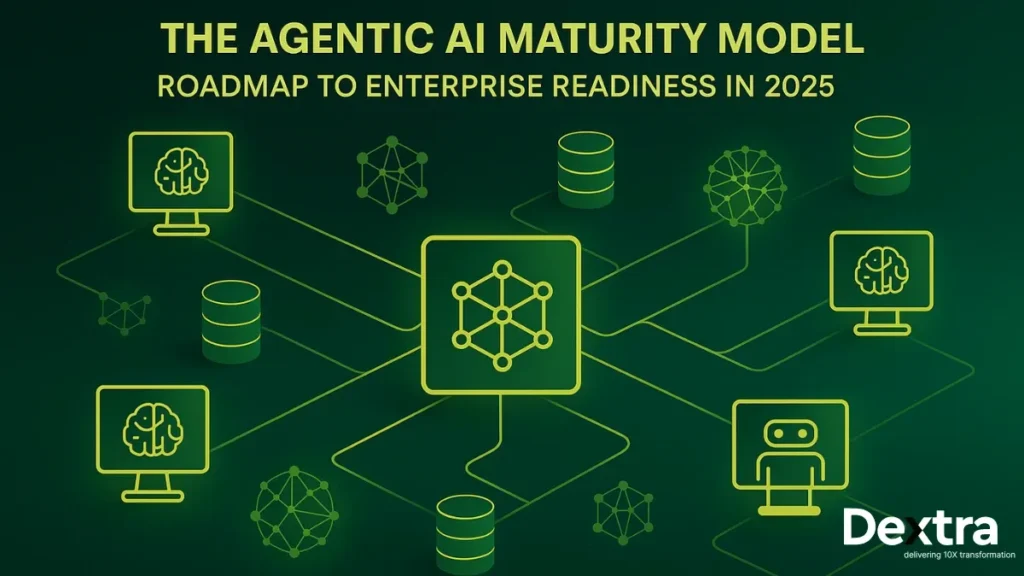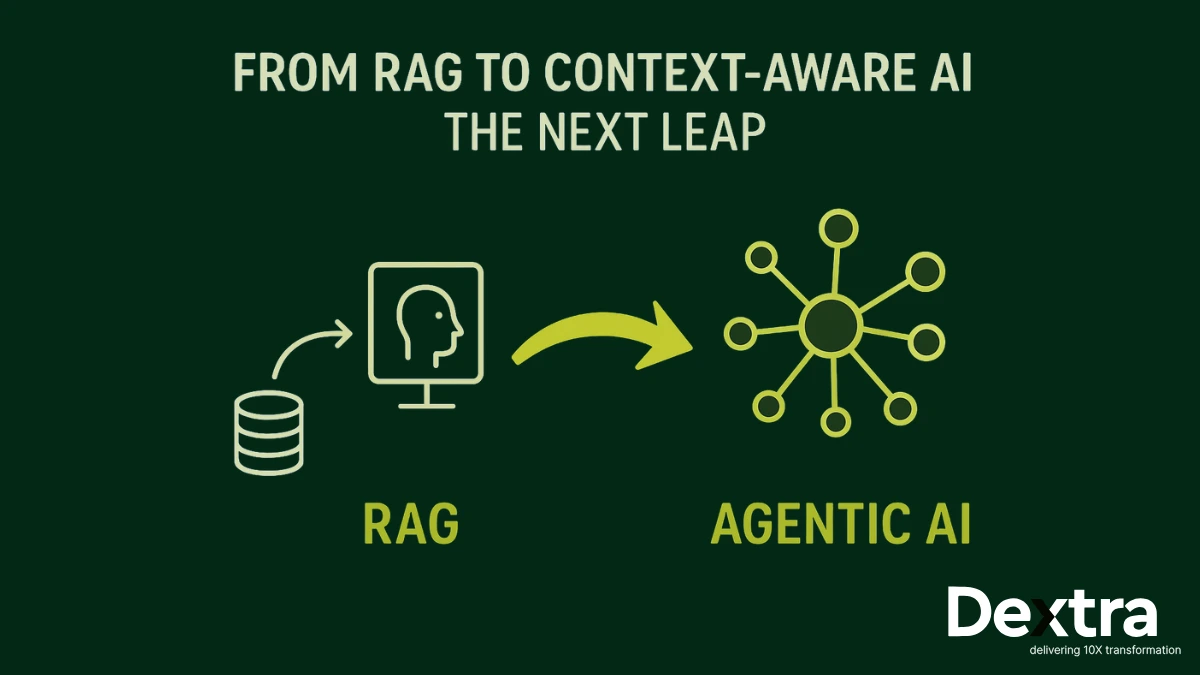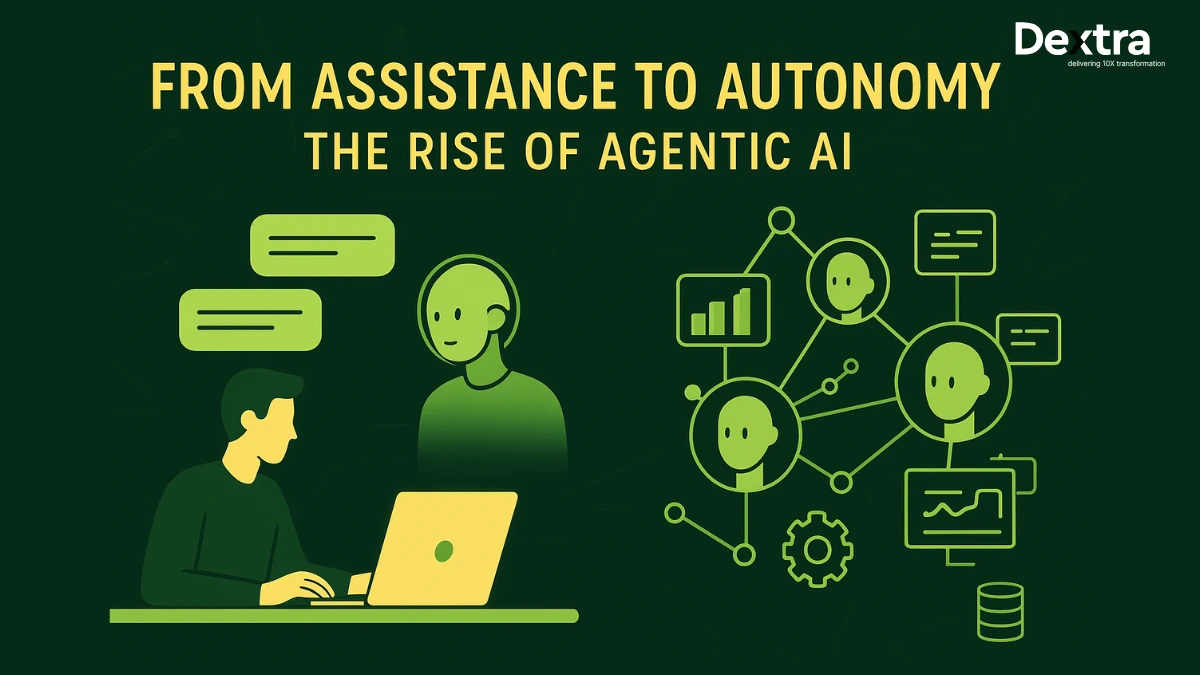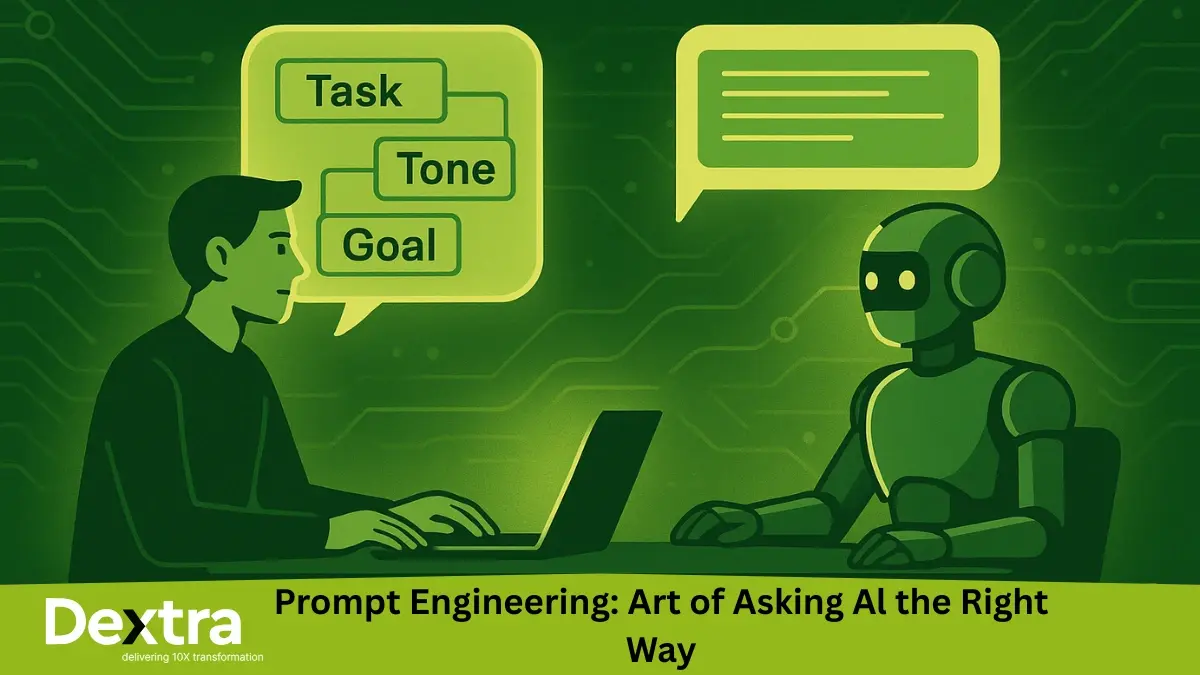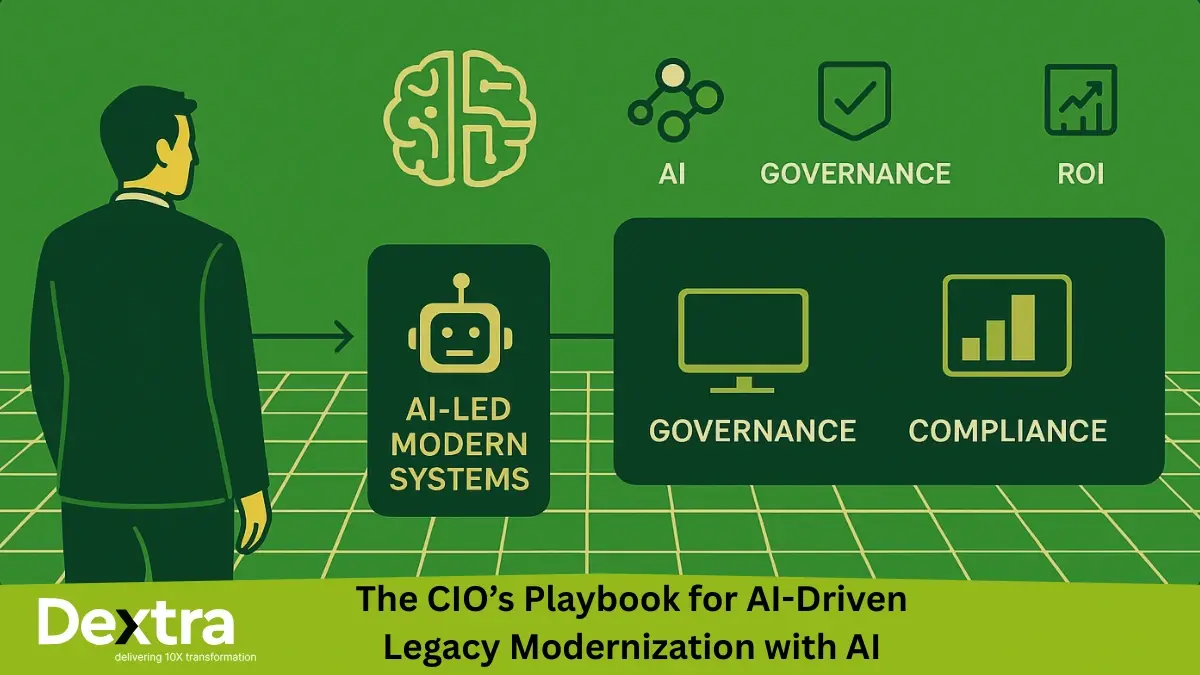A turning point is unfolding in the history of Artificial Intelligence. The first generation of AI co-pilots for human workers has given way to multi-agent ecosystems capable of independent thought, strategy determination, and plan execution, with minimal need for human intervention.
There is growing recognition among business leaders across industries like finance, logistics, government, and energy that isolated applications of AI will only take their organization so far. According to Salesforce, 84% of CIOs believe AI will be as significant to business as the internet. A structured approach backed by a scalable AI deployment strategy for attaining scale, governance, and measurement of ROI is necessary to achieve enterprise-level intelligence.
In countries like the USA, UK, UAE, India, and Singapore, businesses are quickly leaning into this transition. AI consulting companies in the USA are seeing client demands for governance-ready, autonomous AI ecosystems expand for their businesses. AI transformation consulting firms in the UK see clients moving quickly to adopt Agentic AI solutions in London for real-time operational decision-making.
Similarly, experts from AI consulting firms in Dubai and LLM deployment consulting in India are working with governments and startups to orchestrate AI at scale. Even AI governance consulting in Singapore is gaining traction as the region focuses on responsible deployment.
This global transition necessitates one such standardized guide for benchmarking AI evolution-a way to “know” where an enterprise stands and how it can safely scale. That is where the Agentic AI Maturity Model L1-L4 comes into play, as the roadmap for 2025 deployments.
What is the Agentic AI Maturity Model?
The Agentic AI maturity model is a strategic framework that guides enterprises from individual AI copilots to orchestrated autonomous multi-agent systems in 2025. The model is described as a four-step roadmap (four levels) for scaling agentic AI.
At Dextralabs, this is the core model that sits at the center of every enterprise AI transformation engagement. It evaluates an organization’s current AI capabilities but, most importantly, defines a clear road map to achieve Level 4 readiness with AI systems: fully autonomous, governed, and self-learning.
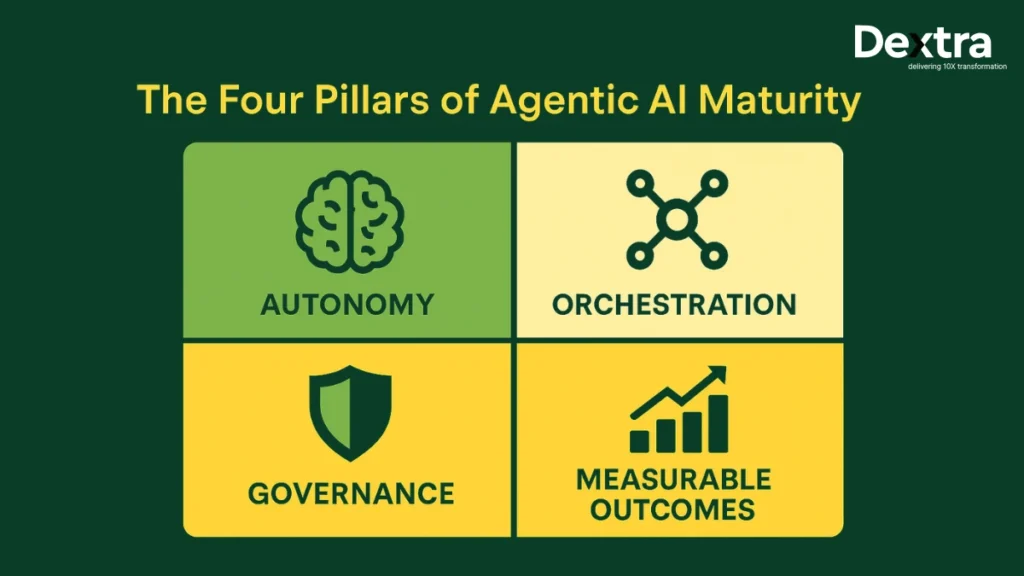
The model is built on four core pillars:
- Autonomy: The degree to which AI agents can make decisions independently.
- Orchestration: the capability to coordinate multiple AI agents in a cross-domain collaboration.
- Governance: Ensuring that all actions taken by AI are compliant with ethical, legal, and operational standards.
- Measurable Business Outcomes: Each AI program should be aligned directly with measurable ROI, productivity, compliance, etc.
With Dextralabs’ broad experience in AI deployment strategy and enterprise AI readiness, an organization receives, besides the framework model itself, a clear execution plan toward sustainable and safe automation. The framework further allows teams to align performance tracking with specific AI KPIs that reflect improvements in efficiency, governance, and scalability.
What are the 4 Levels of Agentic AI Maturity (L1–L4)?
The Agentic AI maturity model defines four levels of increasingly autonomous behavior that characterize how an organization advances from basic automation to an autonomous ecosystem.
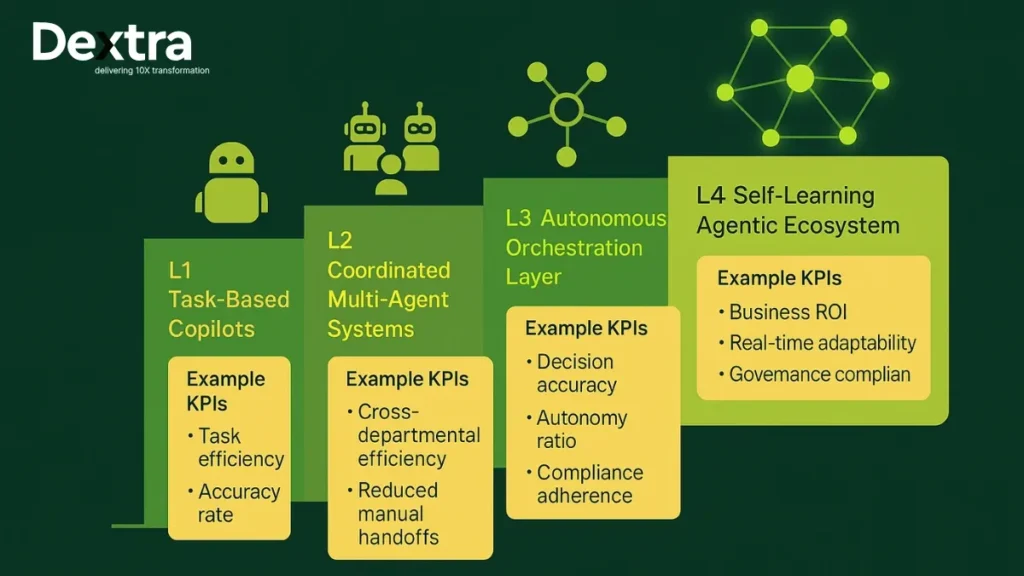
L1: Task-Based Copilots
At Level 1, organizations implement AI copilots in support of task-based automation. These are single-agent systems configured in support of well-defined, repeatable tasks, such as customer service chatbots or document summarizers.
According to salesforce, organisations also ‘define their AI strategy, establish governance and guardrails, and begin connecting data sources.’
- KPIs: Task efficiency, response accuracy, user adoption rate
- Example: A CRM platform with an integrated AI copilot for automated data entry or email responses.
At this level, AI acts as a productivity assistant but still requires human emphasis and direction. Monitoring AI KPIs at this level will enable an organization to help qualify the system’s contribution to productivity uplift and workflow acceleration.
L2: Coordinated Multi-Agent Systems
At Level 2, we see the development of coordinated multi-agent systems where multiple AI agents work together to complete larger workflows with human supervision.
- KPIs: Efficiency across departments, reduced manual handoffs, and improved response loops.
- Example: ERP and CRM systems exchanging data automatically to provide integrated reporting and analytics.
This level of orchestrated multi-agent systems leads to orchestration, where organizations start exploring enterprise AI transformation using intelligent collaboration to integrate their own internal systems.
As part of the consultancy practice at Dextralabs, multi-agent systems 2025 ensure real-time communication between departments, from finance and HR to operations, for agility and quicker decision-making. Dextralabs further aligns each integration phase with a customized AI deployment strategy to ensure maximum scalability and compliance.
L3: Autonomous Orchestration Layer
At Level 3, the organizations have moved from coordination to autonomous orchestration. Various AI agents act with minimal human intervention based on governance layers managing safety, compliance, and monitoring.
- KPIs: Decision quality, autonomy ratio, governance compliance, and response time reduction.
- Example: An international logistics company automates its supply chain management by utilizing an AI workflow that predicts demand, reroutes shipments, and assigns resources.
At this level, Dextralabs integrates AI governance and agent orchestration so that enterprises can monitor and manage the decision-making of agents in real time through observability dashboards and safety layers.
L4: Self-Learning Agentic Ecosystems
Level 4 is the highest on the Agentic AI maturity model — in other words, fully autonomous, continuously learning ecosystems capable of self-optimizing.
- KPIs: Business ROI; governance compliance; real-time flexibility; improvement of customer satisfaction.
- Example: A financial organization using AI agents that automatically analyze risk, adjust strategy, and remain compliant in real time.
These multi-agent systems 2025 learn continuously, share knowledge across domains, and improve service without any need for manual retraining. It is now in this step of the enterprise AI transformation journey that maturity is actually realized with an intelligent AI deployment strategy, enhancing both autonomy and accountability.
Important Safety and Governance Measures
As organizations progress through the Agentic AI maturity model, aspects of governance and safety progressively increase in importance. Without proper controls in place, there is the risk of operational, ethical, and reputational risks from the autonomous agents developed by an organization. We provide solid governance mechanisms at Dextralabs that ensure every AI system is operated transparently, safely, and per international standards.
Key Safety and Governance Measures
- Agent Guardrails: Establish the bounds of what can be done to prevent unwanted or destructive actions.
- Permission Layers: Protects sensitive data with discrete access and encrypted journeys.
- Human-in-the-Loop Checkpoints: Provide expert verification for complex or high-consequence AI outputs.
- Continuous Observability Dashboards: Establish real-time monitoring of performance, compliance, and variance.
- Globally Aligned Compliance: Ensures compliance with frameworks related to the EU AI Act and ISO/IEC AI Governance standards.
This structured, transparent approach reduces risk while providing the basis for trust, accountability, and scaling AI responsibly within organizations.
What are the key Performance Indicators for business success with AI Maturity?
Achieving true AI maturity goes further than providing advanced technology to your business. It is about realizing measurable business outcomes. Organizations harnessing the Agentic AI Maturity Module focus on all measurable and tangible business outcomes, having similar capabilities for key focused KPIs across the tracking of transformation, efficiency, and return on investment.
Primary KPI Categories:
- Efficiency KPIs: Completion time, automation levels, and productivity gains achieved, quantifying the effectiveness of AI to drive efficiency.
- Financial KPIs: Track real monetary outcomes in ROI, operational expenditure reductions, and cloud utilisation to show short-term value to the business.
- Governance KPIs: Review compliance scores, preparedness for auditing, and risk reduction measurements to ensure the responsible, ethical, and compliant use of AI.
- Adoption KPIs: User engagement and satisfaction of AI tools, employee usability experience, and uptime, to calculate internal acceptance and persistent scalability.
Dextralabs Insight:
“At Dextralabs, we map 40 + KPIs to quantifiable business outcomes across industries in our AI maturity assessments. Our advanced AI KPI dashboards benchmark quality of automation, compliance with safety measures, and ROI outcomes for leaders to make informed, thoughtful, data-driven, strategic transformation decisions.
How Enterprises Can Progress Through the Maturity Levels?
Moving up the ladder of the Agentic AI maturity model requires strategy, discipline, and the right partner. Dextralabs has developed a four-step process to help organizations move from Level 1 to Level 4 maturity safely.
Step 1: Discovery
Assess current AI capabilities, architecture, and determination of organizational readiness; identify skill gaps and process bottlenecks.
Step 2: Design
Develop a modular Agentic AI roadmap aligned with the business strategy; create blueprints for agent orchestration, safety, and compliance layers.
Step 3: Deployment
Introduce scalable LLM agents, pipelines, and monitoring frameworks. Dextralabs provides LLM deployment consultation services in India to help you deploy efficiently with governance and alignment to the right AI deployment strategy at every level of the plan.
Step 4: Optimization
Establish continuous improvement loops and AI observability frameworks that allow for continuous performance tuning and adaptation.
During this process, all organizations globally, from AI consulting companies in the USA to Enterprise AI Dubai companies, use these frameworks in order to scale smoothly. The AI strategy for startups in India and AI governance consulting in Singapore also focus on similar blueprints for success.
Global Use Cases: Agentic AI in Action (2025)
Adoption of the Agentic AI maturity model is becoming global in its scope, forming the basis for intelligent automation and a governance-first approach across industries.
USA
Financial organizations are using multi-agent orchestration to conduct predictive risk assessment, fraud detection, and compliance tracking. This has resulted in mass-scale enterprise AI adoptions in the USA and will continue with support from competitive AI consulting firms that emphasize safety-first innovation.
UK
Retail and logistics organizations use Agentic AI solutions in London for inventory prediction and automated restocking. Through AI transformation consulting in the UK, they have been able to increase operational efficiency by more than 40%.
UAE
The government sectors are using multi-agent systems 2025 for smarter, orchestrated cities: traffic systems, citizen service, and strategic infrastructure planning of the city. AI consulting firms in Dubai and Enterprise AI Dubai initiatives are leading this revolution.
India
Manufacturing firms leverage LLM deployment consulting services to create capabilities in production, procurement, and distribution. The AI strategy for Startups in India is on a fast track, enabling the responsible scaling of SMEs.
Singapore & Southeast Asia
Banks and other fintech institutions use AI governance consulting in Singapore to ensure compliance and transparency. Enterprise AI Stack in Southeast Asia is becoming a global standard for safe agentic systems.
These examples have all demonstrated that the Agentic AI maturity model is not a hypothetical framework but rather a dynamic, living framework for transformation in 2025.
Why Dextralabs is Leading the Agentic AI Revolution?
Dextralabs is leading the global Agentic AI revolution, enabling enterprises to go from automation through intelligence orchestration at scale and speed. Dextralabs has deep, cross-domain expertise in all parts of the Agentic AI maturity model: system architecture; large-capacity, deep learning model deployment; governance, security, and multi-agent orchestration.
Core competencies:
- LLM Deployment and Orchestration: Scalable, enterprise-grade deployment and orchestration of large language models tuned to business needs.
- Multi-agent system architecture: An Intelligent system architecture that aligns agents to real-world business objectives.
- AI Safety and Governance Frameworks: Compliance-ready systems, focusing on transparency, accountability, and ethical AI operations.
- Global Consulting Presence: End-to-end delivery and support across the USA, UK, UAE, India, and Singapore.
As a leading AI consulting company in the USA and a trusted enterprise AI partner in Dubai and London, Dextralabs helps organizations break through from simple copilots to full-scale orchestrated AI ecosystems.
Pull Quote:
“Agentic AI is not about replacing humans; it is about orchestrating intelligence across systems. Dextralabs works with Fortune 500 enterprises, governments, and SMEs to build secure, measurable, future-ready AI ecosystems in areas like finance, retail, logistics, and technology.” – CTO Dextra Labs
Conclusion
Would you like to know where your organization stands on the scale of AI maturity?
Book your free Agentic AI Readiness Assessment with Dextralabs today and learn how to create a strategic and safe path to Level 4 autonomy. Dextralabs helps businesses with AI maturity consulting, optimization of multi-agent systems by 2025, and shared measurable benefits through AI readiness. With a global footprint and domain knowledge, Dextralabs helps make sure your enterprise AI transformation is not just innovative but also responsible, scalable, and future-proof.
Q. What is an AI maturity model?
An AI maturity model assesses an organization’s readiness to adopt and scale AI effectively.
It benchmarks capabilities across dimensions like data infrastructure, model deployment, governance, automation, and adoption metrics. Dextralabs’ version extends this concept into the Agentic layer, where AI agents become orchestrators of digital workflows, not just analytical tools.
Q. How does the Agentic AI Maturity Model differ from traditional AI maturity frameworks?
Traditional models measure AI proficiency in terms of data usage, analytics, and automation. The Agentic AI Maturity Model, however, adds autonomy, orchestration, and self-learning as the top tiers of intelligence. It focuses on multi-agent systems, context orchestration, and safety governance — ensuring enterprises achieve autonomy without losing control or compliance alignment.
Q. What is Agentic AI in the pharmaceutical industry?
In pharma, Agentic AI powers autonomous research pipelines, clinical trial data orchestration, and real-time pharmacovigilance.
For example:
– L1 copilots assist in research documentation.
– L2 multi-agent systems coordinate clinical data across geographies.
– L3 orchestration layers automate regulatory compliance workflows.
– L4 ecosystems use self-learning agents to predict drug efficacy and optimize formulation in near real-time.
Dextralabs helps pharma enterprises deploy such regulated, safe, and explainable agentic systems under global compliance frameworks.
Q. What is the maturity assessment of artificial intelligence?
An AI maturity assessment evaluates how effectively an enterprise’s AI systems are deployed, governed, and scaled.
It examines factors such as:
– Model lifecycle management
– AI architecture scalability
– Governance and ethical alignment
– KPI-linked business outcomes
Dextralabs conducts AI Maturity Assessments using its proprietary L1–L4 scoring matrix, which quantifies autonomy, orchestration depth, and compliance strength.
Q. How do you evaluate Agentic AI readiness?
Evaluating Agentic AI readiness involves four dimensions:
Technical – infrastructure for LLMs, APIs, and orchestration pipelines.
Operational – integration maturity across enterprise systems.
Governance – safety guardrails, observability, and audit trails.
Outcome Alignment – measurable ROI, efficiency, and adoption metrics.
Dextralabs uses a 40+ KPI framework that benchmarks your enterprise against industry-leading Agentic AI implementations.
Q. What is the purpose of a maturity assessment in AI transformation?
The purpose of a maturity assessment is to convert AI ambition into measurable progress.
It helps CTOs and innovation heads understand:
Where their AI initiatives stand today.
What gaps exist in architecture or governance.
Which roadmap can lead to scalable autonomy.
It’s the first step toward transitioning from AI pilots to AI platforms — safely and strategically.
Q. What does AI deployment mean in an enterprise context?
AI deployment is the process of integrating trained models, agents, and workflows into an enterprise production environment — ensuring they interact seamlessly with data systems, APIs, and human users. In the Agentic context, deployment extends beyond model hosting — it includes agent orchestration, real-time observability, and adaptive learning loops.
Q. What are the three core phases of AI deployment?
Dextralabs defines three major phases of enterprise AI deployment:
1. Integration Phase — Connecting LLMs and AI agents to existing enterprise stacks.
2. Orchestration Phase — Coordinating agent workflows with minimal human supervision.
3. Optimization Phase — Implementing safety controls, continuous learning, and outcome analytics.
Each phase is governed by AI safety layers and business KPIs to ensure reliability and ROI.
Q. What is the best AI deployment strategy for enterprises?
The best strategy depends on maturity level and risk appetite.
Dextralabs recommends a modular deployment approach:
– Start with L1 copilots to digitize repetitive processes.
– Progress to L2 and L3 orchestration for system-level collaboration.
– Scale to L4 autonomy once governance and safety infrastructure mature.
This incremental pathway ensures controlled evolution, measurable ROI, and regulatory compliance.
Q. How does Dextralabs measure the success of Agentic AI transformation?
Dextralabs quantifies AI success using multi-dimensional KPIs across:
Efficiency (time saved, process automation rate)
Financial ROI (cost savings, revenue uplift)
Governance (compliance and safety adherence)
Adoption (user satisfaction, engagement metrics)
These KPIs form the feedback loop that drives continuous improvement and real-time adaptability in mature Agentic ecosystems.

